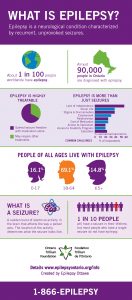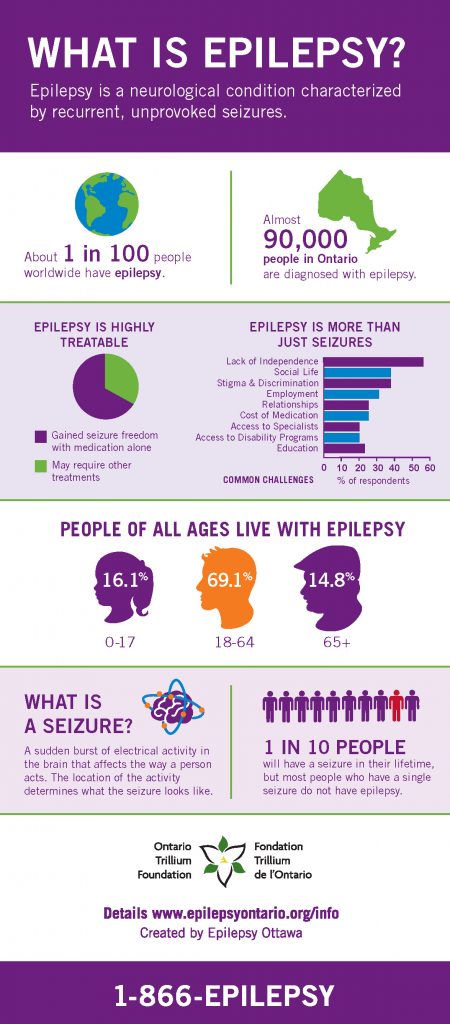
What is epilepsy?
Epilepsy is a neurological condition characterized by recurrent, unprovoked seizures.
A person has epilepsy if they have:
- – at least two unprovoked seizures or
- – one seizure and are very likely to have another or
- – they are diagnosed with an epilepsy syndrome.
The International League Against Epilepsy (ILAE) recently classified epilepsy as a disease to better express the seriousness of epilepsy to the public.
Almost 90,000 people in Ontario are diagnosed with epilepsy.
In 2015, the Ontario Brain Institute (OBI) and the Institute for Clinical Evaluative Sciences (ICES) published the report Brain Disorders in Ontario.
After consulting medical records, they estimate that about 90,000 people in Ontario have epilepsy.
Epilepsy is highly treatable
70% of people with epilepsy can gain seizure freedom with medication alone.
For the other 30% of people with epilepsy, there are a variety of treatment options including surgery, specialized diet, and nerve stimulation. The Epilepsy Implementation Task Force (EITF) recommends that people with epilepsy whose seizures do not respond to two medications, should be assessed to see if they are candidates for surgery.
Epilepsy is more than just seizures
For their report The Impact of Epilepsy on Canadians (2012), Leger Marketing asked respondents to identify the daily challenges of living with epilepsy beyond the seizures themselves. The top three challenges identified were lack of independence including not being able to drive (identified by 56% of respondents), impact on social life (38%), and stigma, discrimination and lack of awareness (38%). Maintaining employment (31%), maintaining relationships (25%), and financial strain due to cost of medications (24%) were not far behind.
These results demonstrate how epilepsy and seizures can make an impact on everyday life well beyond medical concerns.
People of all ages live with epilepsy
Epilepsy does not discriminate. Anyone can develop it at any point in their life from infancy through old age.
According to the 2015 OBI/ICES report, Brain Disorders in Ontario, about 16.1% of Ontarians with epilepsy are 0-17 years old, 69.1% are 18-64 years old, and 14.8% are 65 years old and over.
What is a seizure?
A seizure is a sudden burst of electrical activity in the brain, which causes a temporary disturbance in the way brain cells communicate with each other. The kind of seizure a person has depends on which part and how much of the brain is affected by the electrical disturbance that produces the seizure. A seizure may take many different forms, including a blank stare, uncontrolled movements, altered awareness, odd sensations, or convulsions. Seizures are typically brief and can last anywhere from a few seconds to a few minutes.
About 1 in 10 people will have a seizure in their lifetime.
There are many potential reasons why someone could have a seizure. Some seizures are a symptom of an acute condition, such as an illness or a recent head injury. Some people will have an isolated seizure for no apparent reason and never have another one.
A single seizure is not necessarily epilepsy.
What do I do if I see someone have a seizure?
1. STAY CALM
Most often, a seizure will run its course and end naturally within a few minutes.
2. TIME IT
Call 911 if:
- the seizure lasts more than 5 minutes
- the seizure repeats without full recovery between seizures
- the person is pregnant or has diabetes
- the person is injured from the seizure
- the seizure occurs in water
- you are not sure if the person has epilepsy
3. PROTECT FROM INJURY
- Move sharp objects away.
- If the person falls to the ground, roll them on their side when it is safe to do so.
- Place something soft under their head.
- If the person wanders during their seizure, stay by their side and gently steer them away from danger.
- When the seizure ends, provide reassurance and stay with the person if they are confused.
For a demonstration, watch our seizure first aid videos.







